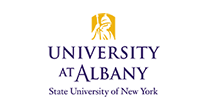News
August 27, 2015UAlbany Drones to Provide Unique Insights into Vegetation Change and Severe Weather through NSF-Funded Study
University at Albany Assistant Professor of Geography and Planning Alexander Buyantuev will lead a team of researchers using unmanned aircraft systems (UAS) — commonly known as drones — to bring new insights into the effects of climate change, urbanization and wind farms on vegetation and analyze severe weather events. The research is funded in part by a National Science Foundation (NSF) Major Research Instrumentation Program award.
The UAS acquisition will augment work Buyantuev is conducting on forest phenology in Albany County, through a UAlbany Faculty Research Award Program grant of approximately $10,000. Using a locally built model airplane and a multi-rotor drone, Buyantuev will monitor vegetation in the Huyck Preserve, 25 miles from UAlbany’s campus, and the Albany Pine Bush in Albany and Guilderland.
The NSF-funded Lancaster platform by Precision Hawk, valued at $148,000, will be used to collect geospatial data at field sites in Upstate New York in support of fundamental and applied ecological and geophysical research. It will be outfitted with professional grade swappable imaging sensors, which Buyantuev also intends to use on his multi-rotor UAS.
Until recently, phenology, the chronology of periodic life-history events in plants and animals, has been mostly studied through ground and spaceborne platform observations. Buyantuev, a landscape ecologist and geographer, said UAS can provide the important missing link between these disparate scales.
“The use of UAS will help in developing a replicable scaling approach between individual plants, communities, and landscapes,” he said. Compared to ground observations, drones provide an improved vantage point and still allow the collection of very high resolution data. “For instance, in our Huyck Preserve observations, plant phenology will be analyzed at individual trees and then scaled to community and landscape levels to be compared with satellite-derived phenology.”
The Precision Hawk drone will serve several ongoing and proposed research projects, including:
- “Effects of climate change on spruce radial growth phenology,” which Buyantuev is conducting with Department of Geography and Planning colleague Andrei Lapenas and Department of Biological Sciences Associate Professor George Robinson;
- “Effects of soil acidification and climate warming on Sugar Maple phenology in the Adirondack Mountains,” also with Lapenas;
- “Detection of wind farm impacts on microclimates and crop/vegetation growth,” a study led by Department of Atmospheric and Environmental Sciences Associate Professor Liming Zhou and Shiguo Jiang of Geography and Planning; and
- “Vegetation analysis in the wildland-urban interface of Albany Pine Bush preserve,” led by Buyantuev and Jiang.
In addition, Buyantuev will support work on severe weather and disaster recovery led by Catherine T. Lawson, associate professor and chair of Geography and Planning, director of UAlbany’s Lewis Mumford Center/Albany Visualization and Informatics Lab (AVAIL). AVAIL has developed a new web tool for identifying post-storm events that will inform a set of simulations to identify best practices for data collection, using UAS technologies. It will support research on meteorological trends, risk factors, storm impacts and best governance practices regarding severe weather.
In addition, Buyantuev will work with geography and planning colleague James Mower to assist the development and testing of Augmented Reality modules for improving drone navigation and aiding image interpretation.
Buyantuev came to UAlbany in 2013 after earning a Ph.D. in geography in Russia and a Ph.D. in plant biology from Arizona State University. His field of landscape ecology investigates spatial and temporal heterogeneity of ecological processes across scales.
He has been particularly interested in transformations of ecological processes, such as vegetation growth and microclimates, in urban environments. In addition to teaching introductory and advanced remote sensing classes, he will offer a new course in urban ecology this fall.
























